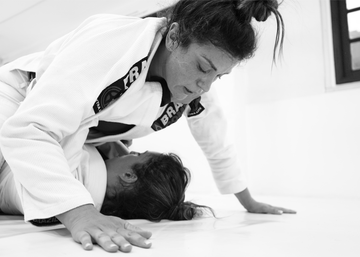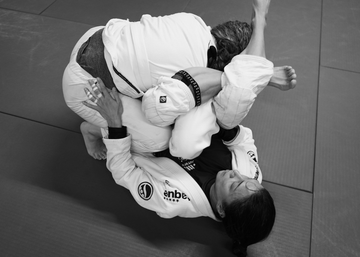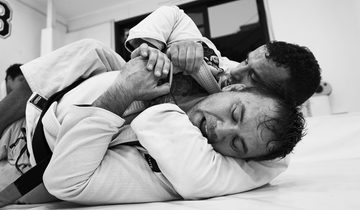Ever stepped on the mat, heart pounding, mind racing, and thought to yourself, 'Man, how should I be breathing right now?' If you've trained in BJJ, you know exactly what I'm talking about. Getting your breath right is as critical as landing that sweep you've been drilling for weeks. So let's break down the breathing game; because let's face it, sometimes it feels like the real opponent is our own lungs.
The Zen of the Mats: A Breather’s Journey
Practice the art of sitting aside and just...breathing. It sounds simple, but as you sit there, with each inhale and exhale, you're actually commanding your diaphragm like a general on the battlefield, getting ready for the upcoming skirmish.
This practice doesn't ask for fancy equipment or extra time; it's just you and your breath, finding harmony. It’s about building that CO2 tolerance, so when you're chest-deep in a tough guard, your body doesn't hit the panic button.
- Breath Hold: The Walker’s Meditation
- Now picture yourself taking a stroll, maybe around the gym or down a quiet street. It's not just any walk; it's your covert operation to strengthen your lungs. With each step, you're breathing through your nose, holding it when it’s time, and counting those steps like they're gold. It’s not about how fast or far you go, but how you keep your cool, even when your body’s screaming for air.
- Movement and Breath: The Stability Ball Dance
- Then there's the dance you do with the stability ball, an unassuming sphere that becomes your partner in this tango of breath and balance. You're moving, breathing, and for a moment, you’re not a fighter; you’re an artist painting the air with each controlled breath.
- Gracie’s Secret: The Percussive Rhythm
- And let's not forget the Gracie’s well-kept secret; percussive breathing. It’s like playing the drums, but the instrument is your lungs, and the music? That’s the oxygen flooding every corner of your body, prepping you for that burst of energy you’ll need when it’s time to escape a tight spot.
Why Bother with Breath?
-
For Your Mind: There's a kind of serenity that comes with mastering your breathing. It's like the world slows down, and even in the midst of a fierce roll, you've got the mental clarity of a monk. That kind of focus? It's gold and gets the gold.
-
For Your Body: Oxygen is the fuel that powers the machine of your body. Get more of it to your muscles, and you'll move like you've got springs in your limbs. It's about having the power to push through when your opponent is banking on you to gas out.
FAQs for the Curious Grappler
-
Q1: "How do I do this percussive breathing thing?" Think of your rib cage as an accordion. When you breathe in deep, you're pulling the accordion apart, and when you exhale with those five sharp beats, you're tapping it back together with control. It's a symphony of breath.
-
Q2: "What's the number one breathing tip for BJJ?" Chill out! (I know easier said than done) but seriously. Before you step onto the mat, find your zen. Tension is the thief of breath, and if you're all wound up, you're going to gas out faster than a leaky balloon.
Breathing techniques to try during your next training and when to use them!
1. Diaphragmatic Breathing (Belly Breathing)
Technique:
- Lie down on your back with knees bent or sit comfortably with your back straight.
- Place one hand on your chest and the other on your abdomen.
- Inhale slowly through your nose, directing the air downward so your abdomen rises while your chest remains relatively still.
- Exhale slowly through your mouth or nose, feeling the hand on your abdomen lower as your diaphragm relaxes.
When to Use:
- During rest periods between rolls.
- While stretching or cooling down post-training.
- At night before sleeping to promote relaxation.
2. Box Breathing (Four-Square Breathing)
Technique:
- Inhale through the nose for a count of four, filling your lungs completely.
- Hold your breath for a count of four.
- Exhale through the mouth for a count of four, emptying the lungs.
- Hold again for a count of four before the next breath.
When to Use:
- Pre-competition or during high-stress moments to induce calm.
- During breaks in training to reset your breathing pattern.
3. Nasal Breathing
Technique:
- Keep your mouth closed and breathe solely through your nose.
- Focus on deep, controlled breaths to maintain a calm heart rate.
- Use it while exercising to improve CO2 tolerance and respiratory efficiency.
When to Use:
- Throughout the day to reinforce the habit.
- During drilling and light rolling to maintain control over your breathing.
4. Recovery Breathing
Technique:
- After intense rolling or sparring, take deep, controlled breaths.
- Inhale for a count of two seconds, then exhale for a count of four seconds.
- Focus on exhaling completely to rid the body of CO2 and facilitate quicker recovery.
When to Use:
- Immediately after intense rounds to lower heart rate and recover faster.
5. Rhythmic Breathing
Technique:
- Match your breathing to a certain rhythm of movement, such as inhaling for two steps while walking and exhaling for the next two.
- In a static position, find a tempo that suits you (e.g., inhale for three counts, exhale for three counts), and maintain this rhythm.
When to Use:
- During warm-ups to get into a flow state.
- While drilling techniques to maintain a relaxed and focused mindset.
6. Progressive Muscle Relaxation with Breathing
Technique:
- Tense a group of muscles as you breathe in, then relax them as you breathe out.
- Work your way through the body, starting from the feet and moving upward.
When to Use:
- As a cool-down method after training to relax the muscles.
- During meditation or relaxation sessions on rest days.
7. Visualization Breathing
Technique:
- As you breathe in, visualize drawing in strength and energy.
- As you exhale, visualize expelling fatigue and tension.
When to Use:
- Before stepping onto the mat to compete.
- Anytime you need to center yourself and refocus.
In Conclusion
Whether you're a seasoned black belt or a white belt with dreams of the podium, remember that Jiujitsu is as much about mastering your breath as it is about mastering the art. So next time you're gearing up for a fight, or even just a tough training session, give these breathing techniques a go. Your lungs – and your Jiujitsu – will thank you for it.





